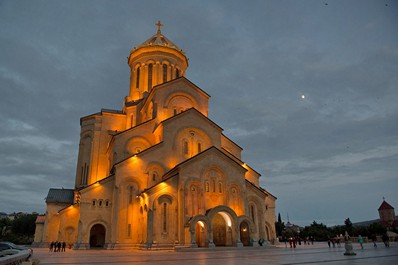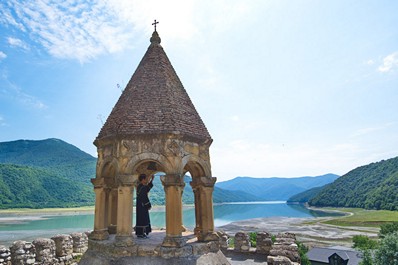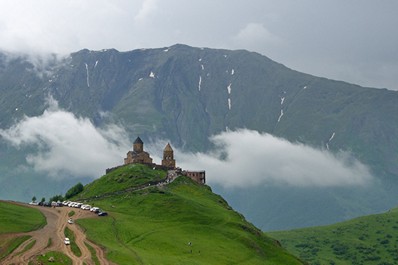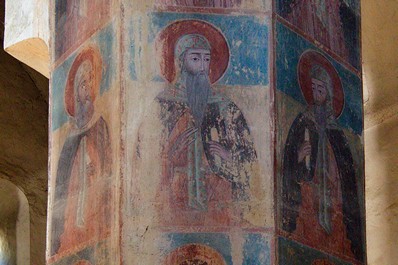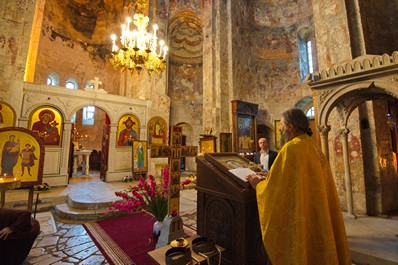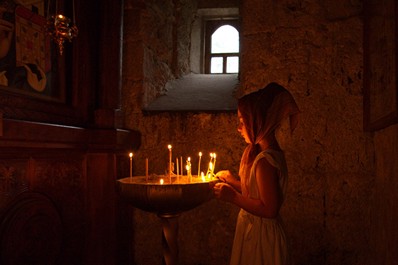
The country of Georgia is an officially secular nation which welcomes followers of all major world religions to practice their faith. Religion in Georgia reached a major turning point in 326 AD, when the nation is largely recognized as the second country in the world (after Armenia) to have adopted Christianity. Today roughly 80% of Georgia’s population identifies as Christian, with most belonging to the Georgian Orthodox Church, the most powerful and influential religious institution in the country.
Islam claims the second largest number of followers in Georgia, most notably among Abkhazians and Georgians from Adjara and other regions in the south. Azerbaijanis, most of whom live in Kvemo Kartli Region, and the majority of the Kist people in Pankisi Gorge also identify as Muslim.
Assyrians, Armenians, Greeks and Russians have their own Orthodox churches in the country, and there are also a small number of Catholics. Georgia is likewise home to one of the oldest Jewish diasporas in the world and to even smaller communities of Lutherans and Doukhobors, a pacifist Christian sect of Russian origin.
Georgian Orthodox Church
According to Orthodox Christianity, in 44 AD Mary the Mother of Jesus and the apostles cast lots to determine where each of them should travel to preach the Holy Word. Ancient church tradition claims that Iberia (now the country of Georgia) was the first of the Four Earthly Domains allotted to Mary, who is now celebrated by Georgian Christians as a patron saint of the country.
Georgian church chronicles state that Mary was unable to travel to Iberia herself and, in accordance with the will of God, remained in Jerusalem. In her stead, she asked the apostle Andrew to go in her place. In those days, there were two kingdoms in what is now modern Georgia: Kartli (Iberia) in the east and Egrisi (Colchis) in the west. Apostle Andrew preached in both, a fact confirmed both by Georgian chroniclers and by Greek and Latin church authors. In the village of Atskuri (close to modern-day Akhaltsikhe), Andrew’s prayer even brought a dead man to life, a miracle which resulted in the first conversions to Christianity in the land. Before he left the village, Andrew placed an image of the Virgin Mary on a wooden plaque as an icon to which the townspeople could pray. The Atskuri Icon of the Mother of God is believed to be the first of its kind and is currently kept in the Georgian National Museum in Tbilisi.
Local Christians were persecuted by authorities for centuries until Christianity became the official state religion in Georgia in 326 AD. Credit for this transformation is given to St. Nino, a female evangelist believed to have born in the Roman province of Cappadocia. After seeing a vision in which the Virgin Mary told her to preach the Gospel in Iberia, St. Nino left for the Caucasus. According to traditional accounts, the young woman erected a large wooden cross atop an old pagan shrine outside of Mtskheta, capital of Iberia. Miraculous events which began to occur around the cross drew pilgrims from all over the Caucasus, and today the site is widely known as Jvari (Cross) Church. St. Nino is also credited with converting King Mirian III of Iberia to Christianity, thus paving the way for the faith to become the official state religion.
Christianity had become firmly established in Georgia by the end of the 4th century, yet in the ensuing centuries Georgia came under attack by the Persians, Arabs, Turks and Mongols, all of whom adhered to other religions. Most of these invaders tried to force the Georgian people to abandon their beliefs, and many were martyred. Despite this tragic chapter in the history of the Georgian church, the faith of the people stood the test of time.
Since the 9th century, the Georgian Orthodox Church has been governed by the Catholicos-Patriarch. In the 12th century, at the height of the Georgian Golden Age, King David the Fourth (better known as King David the Builder) ordered the construction of Gelati Monastery and Academy near Kutaisi. Before long, the institute became known as one of the greatest theological and scientific schools in the Orthodox world. It was hardly alone, for many of the churches and monasteries which dot the Georgian landscape today also served as educational centers in their heyday.
After Georgia became a part of the Russian Empire in the early 19th century, the Georgian Orthodox Church lost its autonomy and was integrated into the Russian Orthodox Church. In contradiction with the official beliefs of the local church, even the Georgian Patriarchate was abolished. On the brink of the 1917 Russian Revolution, Georgian authorities declared their country independent, an act which allowed the sovereignty of the Georgian Church to be reestablished. During the ensuing decades of Soviet rule, atheism, although never officially declared a state ideology, was actively promoted by the ruling party. Most churches were forced to close and many priests were arrested. The revival of Christianity in Georgia came only with perestroika in the 1980s.
Since 1977 until the present day, the head post in the Georgian Orthodox Church has been filled by Ilia the Second, Archbishop of Mtskheta and Tbilisi. Today Christianity in Georgia is at one of its strongest points in history. The country now welcomes thousands of religious tourists annually, who flock to view the relics housed in its historic churches and museums and to visit the many holy places around the country.
Judaism
The country of Georgia is home to one of the oldest Jewish diasporas in the world. According to the medieval Georgian Chronicles, Jews first arrived in Georgia after the capture of Jerusalem in 586 BC by Nebuchadnezzar II, King of Babylon, and the subsequent Babylonian exile. Despite the passing of millennia, the Jewish community in Georgia has managed to retain its faith and culture. Although their numbers decreased sharply in the second half of the 20th century after emigration from the Soviet Union became possible, the majority of those who stayed still reside in Tbilisi, the capital of Georgia. Small Jewish settlements can also be found in Kutaisi, Gori, Surami, Oni, Akhaltsikhe and Batumi. In each of these towns you can find synagogues, many of which are still active.
Armenian Apostolic Church
The Armenian Apostolic Church has been present in Georgia ever since the 5th century A.D., a total of more than 1500 years. In the 11th century it was granted the status of a diocese in Georgia, with Surb Gevorg (Saint George’s Church) in Tbilisi appointed as its administrative center. At one time there were more than 600 distinct religious and cultural sites associated with the Armenian church in Georgia, including seminaries and monasteries, but unfortunately many of them have been destroyed by either natural disaster or vandalism. Most of the Armenian diaspora still residing in Georgia remain strongly devoted to the Armenian Apostolic Church, which currently has 32 active churches in the country. Two of these are in Tbilisi, and the others are mostly located in predominantly Armenian settlements in Kvemo Kartli Region and in the towns of Akhalkalaki, Ninotsminda and Tsalka in Samtskhe-Javakheti Region.
Russian Orthodox Church
The Russian Orthodox Church arrived in Georgia when the country was absorbed into the Russian Empire in 1801. From 1811 to 1917, the Georgian Orthodox Church itself existed as little more than an extension of the Russian Church, as the latter held dominant status.
Followers of the Russian Orthodox religion in Georgia initially consisted almost exclusively of Russian imperial government employees, military personnel and their family members and voluntary civil migrants from other territories of the Russian Empire. During the Soviet era, Russian churches suffered the same fate as religious buildings of nearly every faith – some were destroyed, while many others were used to house public offices, secular organizations, museums, libraries, warehouses and the like.
Today there are three Russian Orthodox churches in Tbilisi, and at each one services are partially held in the Russian language. Alexander Nevsky Cathedral, built in 1864, holds relics of St. Mary Magdalene, St. Nino, St. Nicholas and other revered individuals. Church of St. Michael of Tver, named after the patron saint of Grand Duke Mikhail Alexandrovich Romanov, was built in 1911-1913 as a glowing example of traditional Russian church architecture and is also known for its breathtaking views of Tbilisi. Church of St. John the Theologian, built at the turn of the 20th century, can be recognized by its whitewashed walls and the onion domes which crown its bell tower.
Islam
Islam arrived to Georgia in the 7th century when the army of Osman, Third Caliph of Islam, invaded Eastern Georgia and established Islamic rule. Today, Muslims make up about 10 percent of the Georgian population and can be divided into two main subsets. Georgia’s Sunni Hanafi Muslims are concentrated along the border with Turkey in Adjara Autonomous Republic, a region whose history as a part of the Ottoman Empire naturally led to the spread of Islam in the area. The Ithna Ashariyah Shia Muslims are primarily ethnic Azerbaijanis who reside along the border with Azerbaijan and Armenia. Pankisi Gorge is home to the Kists, an ethnic minority group who predominantly adhere to a form of Sunni Islam. The most ancient and unique mosque in Georgia is Tbilisi’s beautiful 18th-century Juma Mosque, located in Old Tbilisi on the hill between Narikala Fortress and the sulfur baths. The second most prominent mosque is in Batumi, while several smaller mosques can also be found in mountainous Adjara.
Catholicism
The Georgian Catholic community has existed for centuries but has never been large. Today it amounts to approximately 80,000 people, or about 2% of the population. The history of Catholicism in Georgia began in the 13th century, two hundred years after the East-West Schism between the two major branches of Christianity. As this split did not have a huge impact in Georgia, where Orthodox kings were known to have welcomed representatives of the Pope, Catholicism was able to gain a footing. Franciscan missionaries were the first to arrive to Georgia and were soon followed by the Dominicans. As a result of their efforts, a formal Latin episcopal see operated in Georgia from the 13th- 16th centuries.
In the ensuing years, most Catholic churches in Georgia were either transferred to the Georgian Orthodox Church or were destroyed during Soviet rule. Today only a handful of Catholic churches operate in Georgia, the most notable being Cathedral of Our Lady and St. Peter and Paul Church, both in Tbilisi, and Church of The Holy Spirit in Batumi. The gorgeous Holy Annunciation Church in Kutaisi, once a Catholic church, now belongs to the Georgian Orthodox Church.
Many cultural figures of Catholic background have risen to prominence in Georgia, including Zakaria Paliashvili, composer of Georgia’s national anthem and founder of a national composers’ school; Petre Melikishvili, founder of Tbilisi State University; Simon Kaukhchishvili, founder of Georgian classical philology; the Zubalashvili brothers, renowned businessmen and philanthropists; and Sulkhan-Saba Orbeliani, one of the greatest writers, scholars and politicians in the history of Georgia.
Doukhobors
The Doukhobors, whose name means Spirit Wrestler, are both an ethnic group and a religion. All Doukhobors originated in Russia, and today nearly all of them reside in Russia, the Caucasus or in Canada. The Doukhobors refer to themselves as “Orthodox Christians without mediators” and do not attend church. They believe in both reincarnation and the Holy Spirit, do not accept the cross and use many spells and enchantments. As a result, they have always been regarded as a sect by the Russian Orthodox Church.
In 1839, Russian Emperor Nicolas I gave the Doukhobors an ultimatum: either convert to the mainstream religion in Russia or relocate permanently to the newly conquered Caucasus region. As a result, between 1839-1845 about 5,000 Doukhobors settled in the Georgian regions of Javakheti and Dmanisi and established 10 villages: Vladimirovka, Tambovka, Rodionovka, Bogdanovka, Spasovka, Orlovka, Gorelovka, Efremovka, Kalmzkovo, and Troitskoe.
After mass migration of the Doukhobors from Georgia in the 1990s, only one of these villages, Gorelovka, remains on the map. Today the village has 50 homes and about 135 inhabitants. It is a truly unique settlement in Georgia, where Russian is the native language and the people wear the same style of traditional clothing as their ancestors did. Doukhobors are also famous for keeping the tradition of Russian folk singing alive.
Lutheranism
In the early 19th century, German Lutherans became the first protestants to relocate to Georgia, lured in part by promises of religious freedom, exemption from military service, financial assistance and 10 years of tax exemption. In September 1817, the first group of Lutheran immigrants - 31 Swabian German families from Württemberg- arrived in Tbilisi. Over the next two years they established six significant German colonies in Georgia: Marienfeld, Neu-Tiflis, Alexanderdorf, Petersdorf, Elizabettal and Katarinenfeld. Even today, the traditional German architecture seen in these historical areas continues to amaze travelers.
In 1897, the beautiful Saints Peter and Paul Lutheran Church opened on the banks of Mtkvari River in Tbilisi. The well-respected German school located inside the church was allowed to remain open for some years after the Soviets came to power, and even the son of Lavrentiy Beria, head of the Soviet secret police, studied here for a time. Sadly, the church was destroyed after the Lutherans began to face persecution in the early 1930s.
The revival of Lutheranism as a religion in Georgia is associated with the activities of Hert Hummel, a professor from Lutheran University in Saarbrücken, Germany who moved to Georgia in the late 1980s to conduct missionary activities. Hummel eventually sold his house in Germany, and in 1995 he began constructing a new Lutheran church in Georgia. In 1997, exactly 100 years after the original Peter and Paul Lutheran Church was founded, the new Evangelical Lutheran Reconciliation Church opened in Tbilisi. Other Lutheran churches in Georgia include Holy Trinity Protestant Church in Batumi and Evangelical Lutheran Church in Rustavi. A small community of Lutherans also live in the town of Gori.


